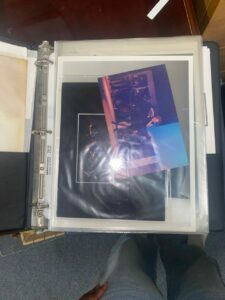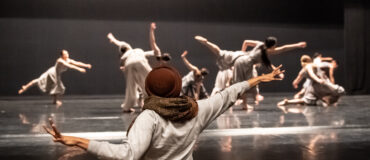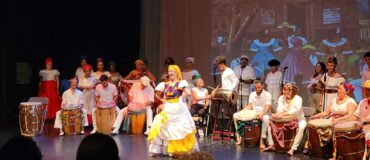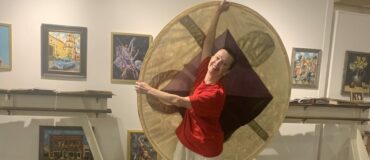By Blair Black
Blair Black is a 2023 Archiving and Preservation Fellow with JazzAntiqua. Read more about the Fellowships here. This is the first part of Blair’s blog. Read the second part here.
A Home for Jazz Dance in Los Angeles
JazzAntiqua is a three-decade-old dance and music ensemble celebrating the interplay within and between African American creative expressions. Indeed, their slogan “Feel the movement in the music” points to the dialogue between Jazz music and dance and nods to the musicality undergirding Black creative cultures. Under the direction of founder and artistic director Pat Taylor, JazzAntiqua has become an institution for Jazz dance and Afrodiasporic culture in Southern California. Since its establishment in 1993, JazzAntiqua has provided community workshops, masterclasses, forums, lecture demonstrations, and panel discussions through their annual “The Movement in the Music Day” during Jazz Appreciation Month in April. During the year, JazzAntiqua regularly hosts free classes through their “LEGACY Jazz Project” which teach teens across Los Angeles the history, technique, theory, and performance of West African dance, Vernacular Jazz Dance, the Katherine Dunham technique, and more.
With our shared interest in providing access to L.A.’s underdocumented creative communities, it is an honor to work with JazzAntiqua to make their collections more sustainable for future generations. As a thought partner, I will assist in developing a foundation of systems and procedures that will allow JazzAntiqua to continue processing their archival materials beyond my tenure. Additionally, JazzAntiqua’s ongoing “Community Salon” oral history project, which consists of intergenerational conversations and personal histories of JazzAntiqua performers, will serve as the organization’s first digital collection. A team consisting of JazzAntqua founder and creative director, Pat Taylor, alongside longtime company dancers Laura Ann Smyth and Bernard Brown, and I will develop a plan to promote the importance and legacy of JazzAntiqua as a hub for the study of West Coast jazz dance to performing arts scholars in and beyond Los Angeles.

Poster of Denzel Washington playing King Richard III in Joseph Papp’s Richard III.
A Home for Your Roots
Throughout its history, JazzAntiqua has performed at a multitude of venues across the city, state, and even overseas. However, none has become as important to their mission and commitment to the jazz aesthetic and culture as the Nate Holden Theatre. JazzAntiqua is situated at the Nate Holden Performing Arts Center (NHPAC) in Los Angeles’s Mid City neighborhood. Named after Los Angeles City Council and California State Senate Member, Nate Holden, the NHPAC serves as a reminder of the indelible mark of African Americans on Los Angeles’s cultural landscape. Pat Taylor shared with me that the two-block strip of Washington Boulevard where the NHPAC resides was once home to a litany of Jazz clubs and lounges after Black Angelenos were allowed to patronize and own business outside of the famous Central Avenue area near downtown Los Angeles. One famous venue, the It Club, where artist Thelonius Monk recorded his album Live At the It Club (1982), is located across the street from the NHPAC. The hallways in the NHPAC celebrate Black expressive culture with visual odes to performers, plays, and musicals. The space holds a nearly 400-seat theatre, dressing room, office, concession area, box office, rehearsal hall and studio, cabaret, and gallery space.
Finding Your 8 Count

Mural of the Nicholas Brothers
Working in a performing arts center means you’re bound to hear an 8 count. This is especially true at the NHPAC, where dancers will often practice in the hallways when the rehearsal room is occupied on busier days. The gentle echo of mentors relaying the choreography to students over their chosen music draws your attention. Here, I had a brief meeting with the resident dance company toddler. A child of a JazzAntiqua dancer, he was dressed similarly to the company dancers: he donned gray sweats, a t-shirt, and the smallest of bare feet. Like a shadow, he followed Bernard in and out of the studio as he went from area to area checking on rehearsals, stage, sound, and light before their performance the following weekend. This toddler reminded me of the unbridled joy and trust I imagine many company members feel as they are led through their journeys in dance by JazzAntiqua. Indeed, many company members have experienced the pull to Pat Taylor and her team and have danced with JazzAntiqua for many years. And going through the collections at JazzAntiqua, you can’t help but notice the same names appearing over multiple years.
Digging Into the Collections

Flyers, booklets, and pamphlets.
Before I started working onsite, my mentor Javier Sepúlveda Garibay, Performing Arts Librarian at the University of Southern California Libraries Music Library, introduced me to JazzAntiqua’s (partial) digital collection held by the archives at USC. This collection contains digitized videos of JazzAntiqua’s early performances and press coverage. Through this small sneak peek, I was able to glean how materials are cataloged and organized, which is important for maintaining consistency as I process the physical items while onsite at the NHPAC. The descriptive metadata, or the data describing the materials, appears fairly straightforward and includes the format, creator, names of performers, location, date, and any legacy identifiers. The naming protocol is also simply constructed with the name of the repository, the creator, and the item number. With this in mind, during the first two weeks on-site I spent most of my time assessing JazzAntiqua’s collection to determine the scope, format, condition, and organization before itemizing the material. JazzAntiqua has an extensive collection of press kits which include original newspaper clippings and copies, pictures and negatives, letters from government officials, and awards. However, the bulk of the collection is a variety of ephemera such as flyers, booklets, ticket stubs, and postcards from events that included or were presented by JazzAntiqua.
Developing the JazzAntiqua Archive and Preservation Plan
- Magazines, photos, and newspapers from the archive
One of my favorite components of processing archives is learning the story of a collection and/or institution through the materials. With material documenting events spanning nearly three decades, JazzAntiqua’s material is as extensive as the dance company is prosperous! To ensure the collections are processed up to established archival standards and practices, I’ll share my knowledge with Bernard, who has expressed an interest in archiving. JazzAntiqua has created an oral history series through their program “The Community Salon” to document the stories of dance masters, musicians, and former students, where they discuss their participation in the company and Los Angeles’s larger jazz community. Additionally, “The Community Salon” also hosts an intergenerational gathering for conversation and exchange of ideas that explores topics rooted in the jazz experience. After talking with Javier, Pat, Laura, and Bernard about the direction of the archive we decided that between inventorying, developing workflows, and training staff in basic archival processing, I would help them to brainstorm plans that will showcase these histories and conversations to share with the public. As I continue this fellowship I am excited to learn more about the different iterations of JazzAntiqua’s history through the stories of dancers who worked with the ensemble.
Header photo: JazzAntiqua Dance & Music Ensemble performing “Freedom! Jazz! Dance!” 25th Anniversary Concert (2018) at the Nate Holden Performing Arts Center. Pictured: Paul Livingstone (bass), Albertossy Espinoza, Sarah Platte, Autumn Randolph, Justin Edmonson. Photographer: George Simian. Courtesy of JazzAntiqua.
All other photos courtesy of the author.
 A Los Angeles native, Blair Black (she/her) is a doctoral candidate in UCLA’s Ethnomusicology department. Her work focuses on the representational politics of underrepresented communities within electronic dance music and club cultures. Her dissertation studies the aesthetic developments and discursive strategies people of color and queer communities employ in navigating (in)formal EDM industries. A recipient of the University of California’s Dissertation Year & Eugene V. Cota-Robles Fellowships, Blair has worked with projects such as the Center for the Study of Women’s Chemical Entanglements Oral History Project, the Center for Oral History Research’s Black LGBTQ in Los Angeles Oral History Project & UCLA Herb Alpert School of Music Library’s forthcoming My Life in the Sunshine: Sampling the Soundscape of Black Los Angeles Exhibit. An aspiring archivist, she’s worked closely with Southern California repositories (UCLA’s Ethnomusicology Archive & The ONE Archives at USC) and hopes to continue processing collections of underdocumented communities with JazzAntiqua. Photo courtesy of Blair Black.
A Los Angeles native, Blair Black (she/her) is a doctoral candidate in UCLA’s Ethnomusicology department. Her work focuses on the representational politics of underrepresented communities within electronic dance music and club cultures. Her dissertation studies the aesthetic developments and discursive strategies people of color and queer communities employ in navigating (in)formal EDM industries. A recipient of the University of California’s Dissertation Year & Eugene V. Cota-Robles Fellowships, Blair has worked with projects such as the Center for the Study of Women’s Chemical Entanglements Oral History Project, the Center for Oral History Research’s Black LGBTQ in Los Angeles Oral History Project & UCLA Herb Alpert School of Music Library’s forthcoming My Life in the Sunshine: Sampling the Soundscape of Black Los Angeles Exhibit. An aspiring archivist, she’s worked closely with Southern California repositories (UCLA’s Ethnomusicology Archive & The ONE Archives at USC) and hopes to continue processing collections of underdocumented communities with JazzAntiqua. Photo courtesy of Blair Black.
____
We accept submissions on topics relevant to the field: advocacy, artistic issues, arts policy, community building, development, employment, engagement, touring, and other topics that deal with the business of dance. We cannot publish criticism, single-company season announcements, and single-company or single artist profiles. Additionally, we welcome feedback on articles. If you have a topic that you would like to see addressed or feedback, please contact communications@danceusa.org.
Disclaimer: Opinions expressed in guest posts do not necessarily represent the viewpoints of Dance/USA.









